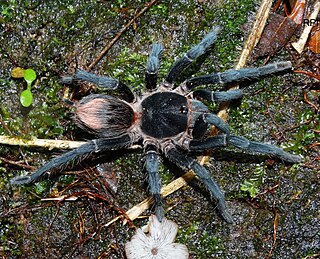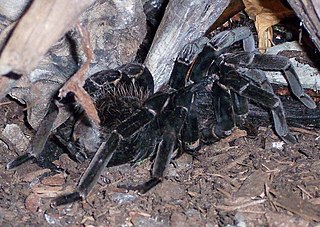
Pamphobeteus is a genus of tarantulas that was first described by Reginald Innes Pocock in 1901. It includes some of the largest spiders in the world. They are found in South America, including the countries of Peru, Bolivia, Ecuador, Brazil, Colombia and Panama.

Psalmopoeus is a genus of the family Theraphosidae containing various species of tarantulas. The genus is native to Trinidad and Tobago, Colombia, Ecuador, Venezuela, Guyana, Brazil, Belize, Panama, Nicaragua, Costa Rica, Mexico, Guatemala and Honduras. All of these tarantulas are arboreal in nature, Psalmopoeus victori being the first arboreal tarantula of Mexico.

Tarantulas comprise a group of large and often hairy spiders of the family Theraphosidae. As of December 2023, 1,100 species have been identified, with 166 genera. The term "tarantula" is usually used to describe members of the family Theraphosidae, although many other members of the same infraorder (Mygalomorphae) are commonly referred to as "tarantulas" or "false tarantulas". Some of the more common species have become popular in the exotic pet trade. Many New World species kept as pets have setae known as urticating hairs that can cause irritation to the skin, and in extreme cases, cause damage to the eyes.

Cyriocosmus is a genus of tarantulas that was first described by Eugène Louis Simon in 1903. They are small to medium spiders, with a bicolored or one same color carapace.
Hapalotremus is a genus of South American tarantulas in the Theraphosinae subfamily that was first described by Eugène Louis Simon in 1903. They have red or white Type III urticating hairs, up to 1.2 millimetres (0.047 in), with a fine point and barbs along at least half of the lower part. The tibial apophysis is branched twice, and there is a conspicuous subapical keel on the male's embolus.

Nhandu is a genus of South American tarantulas that was first described by S. Lucas in 1983. Brazilopelma was synonymized with it in 2001.

Thrixopelma is a genus of South American tarantulas that was first described by Günter E. W. Schmidt in 1994. They are medium to large tarantulas, usually being 35mm to 60mm in body length.

Homoeomma is a genus of South American tarantulas that was first described by Anton Ausserer in 1871. It is considered a senior synonym of Calopelma, Butantania, and of Cyclothoracoides. These tarantulas are usually quite small and usually burrow a few centimeters under a rock or log.

Lampropelma is a genus of Indonesian tarantulas that was first described by Eugène Louis Simon in 1892. As of March 2020 it contains two species, found in Indonesia.
Phormingochilus is a genus of Bornean tarantulas that was first described by Reginald Innes Pocock in 1895. They are occasionally kept as exotic pets, and are known for moving in bursts of speed and being defensive when cornered.

Xenesthis is a genus of tarantulas that was first described by Eugène Louis Simon in 1891. As of February 2024 it contains five species, found in Colombia and Venezuela, though it was previously considered to be found in Panama.
Euthycaelus is a genus of tarantula. It was first described in 1889 by Simon, and is found through Central and South America.
Melognathus is a monotypic genus of southeast Asian tarantulas containing the single species, Melognathus dromeus. It was erected in 1917 for a holotype collected from a ship that visited southeast Asia. In 1985, the species was moved to Cyriopagopus because the autapomorphies were not considered significant enough to warrant a new genus. Opinions between biologists were split, some using the original name and some using Cyriopagopus. In a 2019 report, Gabriel and Sherwood pointed out that in addition to the differences in pedipalp morphology, the holotype exhibits leg features that indicate an arboreal species, while species of Cyriopagopus are largely terrestrial. The ambiguous location of the holotype has left room for speculation, but as of February 2022 the World Spider Catalog accepts this genus.
Rick C. West is a Canadian arachnologist and an expert on the taxonomy of tarantula spiders. West was born in Victoria, British Columbia. He has been interested in spiders since childhood, and collected his first tarantula, Aphonopelma eutylenum, at the age of 13. He worked primarily as a Chief Constable for a local Animal Humane Society, but also have been involved with the collecting, breeding, rearing and photography of theraphosid spiders. West has traveled to over 27 countries to document and study them in their environment, has been a host, presenter and co-producer in several tarantula documentaries and has also described several genera and species.
Umbyquyra is a genus of South American tarantulas first described in 2018 by Gargiulo, Brescovit & Lucas. They are found exclusively in Brazil and Bolivia. The name Umbyquyra derives from the words "pointed bird beak" in the native Tupi language, which makes reference to the palpal bulb.

The Selenocosmiinae are a subfamily of tarantulas found throughout South-East Asia and Australia. This subfamily is defined by the presence of a lyra on the maxillae and strikers on the chelicerae, allowing these spiders to stridulate and produce a "hissing" sound. However some species within Phlogiellus may have secondary lost their lyra but retain their strikers. The monophyly of the subfamily has been only tested using genetic data with a handful of genera or species in a few studies. However, these studies found genera that had been previously placed in this subfamily were actual their own separate subfamily (Poecilotheria) and that Selenocosmiinae is most closely related to the Indian Thrigmopoeinae. As of 2021, Selenocosmiinae contains 11 genera.
Spinosatibiapalpus is a genus of tarantulas erected by Gabriel and Sherwood in 2020 for a newly discovered species and two other previously described species bearing a unique palpal bulb morphology. The name is a reference to the spines found on the fourth section of the pedipalp in adult males. This distinctive feature was also found in Pseudhapalopus species, but because it is never mentioned in the original description of that genus, Gabriel and Sherwood called into question the validity of Pseudohapalopus, and moved all its species except P. aculeatus, known only from a single male found in Bolivia in 1907. It is impossible to place P. aculeatus because the holotype was destroyed when the museum housing it was bombed during World War II, and it has been declared as nomen dubium.
Cymbiapophysa is a genus of spiders in the family Theraphosidae, first described by Pocock, in 1903. As of 2024 it contains 12 species. The tarantulas of this genus inhabit Central America. Males of this genus can be distinguished by the presence of a distal retrolateral apophysis on the cymbium of the male pedipalp. And females can be distinguished with twin spermathecae, by the morphology and the short and squat receptacles.
Murphyarachne is a monotypic genus of Peruvian tarantulas, with one species, Murphyarachne ymasumacae. It was first described by Sherwood and Gabriel in 2022. The genus is named after Frances Mary Murphy and John Alan Murphy for their contributions to arachnology, and the Greek term "arachne", which is the word for spider.
Bermejoa is a monotypic genus of tarantula, first described by Gabriel, Sherwood and Pérez-Miles in 2023. Bermejoa zoeae its only known species, is found in Bolivia. The name Bermejoa comes from Bermejo which is the name of a nearby town and the name of the river that is close to the type locality. This is part of the Dry Chaco region, this species in particular being found in a semi-decious forest, at an elevation of roughly 1000m above sea level. The species epithet is a matronym in honour of Zoë Simmons, who is one of the collectors of the specimen.









